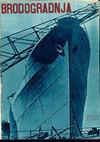对几种常规船体形式的阻力和功率参数化软件的预测精度进行了研究
IF 4.2
4区 工程技术
Q1 ENGINEERING, MARINE
引用次数: 9
摘要
阻力和功率的初步预测是船舶设计过程的一个基本方面,因为它们直接影响设计过程的发展,燃料消耗和成本,以及从早期设计阶段对环境的影响。电阻和功率的参数预测,主要基于统计回归模型,也是理想的计算机编程,通常在初始设计阶段进行,提供最小电阻的快速预测和优化。本文介绍了笔者开发的船舶阻力和动力参数预测计算机程序对一些常规船体预测精度的对比分析结果。该程序(名为Ship Power V 1.0)是在Visual Basic 6.0环境下基于两个著名的回归模型Holtrop和Van Oortmerssen开发的。该程序可以执行阻力和功率、阻力系数、螺旋桨推力、船体效率、尾流和信任分数的详细预测,对速度的数量没有限制。在本研究中,只考虑电阻和功率预测的准确性分析。通过对ridgly - nevitt系列拖网渔船和KCS船体三种型号的计算结果,对比分析了Ship Power V 1.0的计算过程与实验数据,并与另一知名商业软件的计算结果进行了对比分析,结果表明该软件的准确性和可靠性与其他知名商业软件相当。本文章由计算机程序翻译,如有差异,请以英文原文为准。
INVESTIGATION ON SOME CONVENTIONAL HULLS FORMS OF THE PREDICTIVE ACCURACY OF A PARAMETRIC SOFTWARE FOR PRELIMINARY PREDICTIONS OF RESISTANCE AND POWER
Preliminary prediction of resistance and power is a fundamental aspect of the ship design process since they directly influence the developments of the design process, fuel consumption and costs, and environmental impact from the early design stage. Parametric predictions of resistance and power, based mainly on statistical regression models that are also ideal for computer programming, are often performed during initial design stages, providing rapid predictions and optimisations for minimum resistance. The paper aims to present the results of the comparative analysis on some conventional hulls of the predictive accuracy of a computer program developed by the author for parametric predictions of resistance and power of ships. The program (entitled Ship Power V 1.0) is developed in the Visual Basic 6.0 environment based on two well-known regression models Holtrop and Van Oortmerssen. The program can perform detailed predictions of resistance and power, resistance coefficients, propeller thrust, hull efficiency, wake, and trust fractions, with no restriction on the number of velocities. In this study, only the analysis of the accuracy of resistance and power prediction is considered. Results of the comparative analysis of the computational procedures of Ship Power V 1.0 versus experimental data, and against results of another well-known commercial software, performed on three models of the Ridgely-Nevitt trawler series and KCS hull have shown a good level of accuracy and reliability as other well-known commercial software.
求助全文
通过发布文献求助,成功后即可免费获取论文全文。
去求助
来源期刊

Brodogradnja
ENGINEERING, MARINE-
CiteScore
4.30
自引率
38.90%
发文量
33
审稿时长
>12 weeks
期刊介绍:
The journal is devoted to multidisciplinary researches in the fields of theoretical and experimental naval architecture and oceanology as well as to challenging problems in shipbuilding as well shipping, offshore and related shipbuilding industries worldwide. The aim of the journal is to integrate technical interests in shipbuilding, ocean engineering, sea and ocean shipping, inland navigation and intermodal transportation as well as environmental issues, overall safety, objects for wind, marine and hydrokinetic renewable energy production and sustainable transportation development at seas, oceans and inland waterways in relations to shipbuilding and naval architecture. The journal focuses on hydrodynamics, structures, reliability, materials, construction, design, optimization, production engineering, building and organization of building, project management, repair and maintenance planning, information systems in shipyards, quality assurance as well as outfitting, powering, autonomous marine vehicles, power plants and equipment onboard. Brodogradnja publishes original scientific papers, review papers, preliminary communications and important professional papers relevant in engineering and technology.
 求助内容:
求助内容: 应助结果提醒方式:
应助结果提醒方式:


